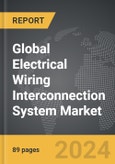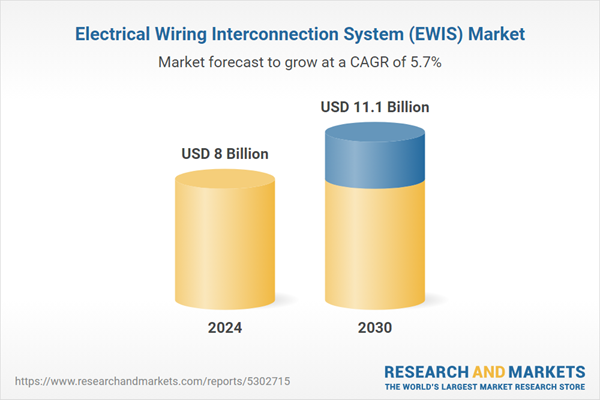Global Electrical Wiring Interconnection System (EWIS) Market - Key Trends & Drivers Summarized
Why Is Electrical Wiring Interconnection System (EWIS) Essential in Modern Aerospace and Automotive?
The Electrical Wiring Interconnection System (EWIS) is a critical component in complex vehicles, particularly in aerospace and automotive industries, where it ensures the efficient, safe, and reliable transmission of power, signals, and data across various subsystems. In the aerospace sector, EWIS includes the complete wiring and interconnection systems responsible for transmitting electrical power, data, and signals to support vital operations, from avionics and lighting to fuel and hydraulic systems. EWIS is essential for ensuring high levels of safety, as it minimizes the risk of electrical faults, reduces electromagnetic interference (EMI), and meets stringent regulatory requirements that prioritize aircraft safety.With the growing trend toward electrification and automation, the role of EWIS in modern aircraft and electric vehicles (EVs) is expanding. In the automotive sector, particularly with EVs, EWIS enables the integration of high-voltage systems and autonomous driving technologies, supporting functionalities such as battery management, electric power distribution, and sensor networks. As aircraft and vehicles become increasingly electrified and reliant on data-intensive systems, EWIS components are crucial for ensuring uninterrupted operations, reducing the risk of component failures, and optimizing energy efficiency. The increasing sophistication of modern transportation systems continues to drive demand for more resilient, lightweight, and intelligent EWIS solutions, making them a backbone of advanced mobility infrastructure.
How Are Technological Innovations Impacting the EWIS Market?
Advancements in materials and design technology are driving innovation in EWIS, enabling systems that are lighter, more durable, and better suited to the high demands of modern aerospace and automotive applications. Lightweight materials, including advanced composites and high-performance thermoplastics, are increasingly used in EWIS to reduce the overall weight of aircraft and vehicles, which is critical for improving fuel efficiency and range. These materials provide excellent thermal resistance, fire retardancy, and durability, making them ideal for extreme operating environments. Additionally, the development of high-speed data cables and fiber optic technology has allowed EWIS to handle higher data transmission rates, essential for the growing data demands of modern avionics and autonomous vehicle systems.Automation and artificial intelligence (AI) are also influencing EWIS by streamlining the design, assembly, and maintenance processes. AI-driven modeling software helps engineers optimize EWIS layout and routing, enhancing efficiency and reducing wiring weight by designing shorter, more direct connections. Innovations in modular design have enabled more flexible EWIS configurations, which support efficient upgrades and simplify maintenance in aircraft and EVs. Furthermore, smart wiring harnesses equipped with sensors allow real-time monitoring of EWIS components, enabling predictive maintenance and reducing the risk of unexpected failures. These technological advancements make EWIS more adaptable, efficient, and robust, supporting the evolving requirements of high-tech transportation systems.
What Are the Key Applications of EWIS?
EWIS is used extensively in both aerospace and automotive industries, supporting the critical electrical, communication, and control functions required for safe and efficient operations. In aerospace, EWIS applications cover everything from flight control systems and avionics to power distribution and in-flight entertainment, connecting essential components and subsystems throughout an aircraft. Aircraft wiring systems are designed to be resilient, meeting stringent regulations for fire resistance, EMI shielding, and thermal stability. For instance, EWIS in aircraft supports safety-critical systems like hydraulic controls, landing gear, and fuel pumps, where reliable wiring interconnections are paramount to safe flight operations.In the automotive sector, particularly in electric and autonomous vehicles, EWIS plays a significant role in supporting high-voltage power distribution, battery management, and sensor integration. In EVs, EWIS systems connect battery packs to motors, inverters, and auxiliary components, facilitating efficient energy transfer and supporting high-current loads. Autonomous driving technology also relies on EWIS for connectivity between numerous sensors, control modules, and data processing units that enable real-time decision-making. Additionally, as vehicles become more connected and feature-rich, EWIS is increasingly used to support infotainment, advanced driver-assistance systems (ADAS), and communication systems. These applications demonstrate the versatility of EWIS in integrating complex, high-performance electrical systems across various platforms, from aircraft to advanced electric and autonomous vehicles.
What Is Driving Growth in the EWIS Market?
The growth in the EWIS market is driven by several factors, including the rise of electric and autonomous vehicles, increased aircraft production, regulatory safety requirements, and the growing emphasis on lightweight solutions. The global shift towards electric mobility is expanding the demand for EWIS, as electric and hybrid vehicles require extensive wiring systems to manage high-voltage power and support numerous electrical components. The expansion of the electric vehicle market, coupled with advancements in autonomous driving, requires sophisticated wiring systems capable of handling complex sensor networks and data processing requirements, further boosting the demand for EWIS in the automotive industry.In the aerospace sector, increasing aircraft production, driven by rising passenger demand and fleet expansion, is a major growth driver for EWIS. Aircraft manufacturers are focusing on lightweight, fuel-efficient designs, making the demand for lightweight EWIS components particularly high. Regulatory standards for aircraft safety, such as those set by the Federal Aviation Administration (FAA) and the European Union Aviation Safety Agency (EASA), mandate rigorous standards for EWIS design, further driving the adoption of advanced, compliant materials and configurations. Additionally, the adoption of predictive maintenance technologies in EWIS systems aligns with the industry's shift toward proactive maintenance, reducing operational costs and enhancing safety.
The rising need for connectivity, automation, and real-time data processing in vehicles and aircraft is also influencing the EWIS market, as smart wiring systems capable of high data throughput become necessary to support advanced functions. Together, these factors - electrification in transportation, stringent safety regulations, lightweight material adoption, and connectivity needs - are driving strong growth in the EWIS market, establishing it as a cornerstone of modern transportation infrastructure across automotive and aerospace sectors.
Report Scope
The report analyzes the Electrical Wiring Interconnection System (EWIS) market, presented in terms of market value (US$ Thousand). The analysis covers the key segments and geographic regions outlined below.- Segments: Application (Avionics, Interiors, Powerplant, Airframe, Other Applications); End-Use (OEM, Aftermarket).
- Geographic Regions/Countries:World; United States; Canada; Japan; China; Europe (France; Germany; Italy; United Kingdom; Spain; Russia; and Rest of Europe); Asia-Pacific (Australia; India; South Korea; and Rest of Asia-Pacific); Latin America (Argentina; Brazil; Mexico; and Rest of Latin America); Middle East (Iran; Israel; Saudi Arabia; United Arab Emirates; and Rest of Middle East); and Africa.
Key Insights:
- Market Growth: Understand the significant growth trajectory of the Avionics Application segment, which is expected to reach US$3.4 Billion by 2030 with a CAGR of a 5.7%. The Interiors Application segment is also set to grow at 6.3% CAGR over the analysis period.
- Regional Analysis: Gain insights into the U.S. market, valued at $2.1 Billion in 2024, and China, forecasted to grow at an impressive 8.5% CAGR to reach $2.5 Billion by 2030. Discover growth trends in other key regions, including Japan, Canada, Germany, and the Asia-Pacific.
Why You Should Buy This Report:
- Detailed Market Analysis: Access a thorough analysis of the Global Electrical Wiring Interconnection System (EWIS) Market, covering all major geographic regions and market segments.
- Competitive Insights: Get an overview of the competitive landscape, including the market presence of major players across different geographies.
- Future Trends and Drivers: Understand the key trends and drivers shaping the future of the Global Electrical Wiring Interconnection System (EWIS) Market.
- Actionable Insights: Benefit from actionable insights that can help you identify new revenue opportunities and make strategic business decisions.
Key Questions Answered:
- How is the Global Electrical Wiring Interconnection System (EWIS) Market expected to evolve by 2030?
- What are the main drivers and restraints affecting the market?
- Which market segments will grow the most over the forecast period?
- How will market shares for different regions and segments change by 2030?
- Who are the leading players in the market, and what are their prospects?
Report Features:
- Comprehensive Market Data: Independent analysis of annual sales and market forecasts in US$ Million from 2024 to 2030.
- In-Depth Regional Analysis: Detailed insights into key markets, including the U.S., China, Japan, Canada, Europe, Asia-Pacific, Latin America, Middle East, and Africa.
- Company Profiles: Coverage of players such as A.E. Petsche, Akka Technologies, Ametek, Amphenol, Carlisle Companies and more.
- Complimentary Updates: Receive free report updates for one year to keep you informed of the latest market developments.
Some of the 34 companies featured in this Electrical Wiring Interconnection System (EWIS) market report include:
- A.E. Petsche
- Akka Technologies
- Ametek
- Amphenol
- Carlisle Companies
- Co-Operative Industries Aerospace & Defense (Cia&D)
- Ducommun
- Elektro Metall Export (EME)
- Esterline Corporation
- GKN Aerospace
- Interconnect Wiring
- Latécoère
- Leviton
- Pic Wire & Cable
- Radiall
- Rockwell Collins
- Safran
- Te Connectivity
- W.L. Gore & Associates
This edition integrates the latest global trade and economic shifts into comprehensive market analysis. Key updates include:
- Tariff and Trade Impact: Insights into global tariff negotiations across 180+ countries, with analysis of supply chain turbulence, sourcing disruptions, and geographic realignment. Special focus on 2025 as a pivotal year for trade tensions, including updated perspectives on the Trump-era tariffs.
- Adjusted Forecasts and Analytics: Revised global and regional market forecasts through 2030, incorporating tariff effects, economic uncertainty, and structural changes in globalization. Includes historical analysis from 2015 to 2023.
- Strategic Market Dynamics: Evaluation of revised market prospects, regional outlooks, and key economic indicators such as population and urbanization trends.
- Innovation & Technology Trends: Latest developments in product and process innovation, emerging technologies, and key industry drivers shaping the competitive landscape.
- Competitive Intelligence: Updated global market share estimates for 2025, competitive positioning of major players (Strong/Active/Niche/Trivial), and refined focus on leading global brands and core players.
- Expert Insight & Commentary: Strategic analysis from economists, trade experts, and domain specialists to contextualize market shifts and identify emerging opportunities.
Table of Contents
Companies Mentioned (Partial List)
A selection of companies mentioned in this report includes, but is not limited to:
- A.E. Petsche
- Akka Technologies
- Ametek
- Amphenol
- Carlisle Companies
- Co-Operative Industries Aerospace & Defense (Cia&D)
- Ducommun
- Elektro Metall Export (EME)
- Esterline Corporation
- GKN Aerospace
- Interconnect Wiring
- Latécoère
- Leviton
- Pic Wire & Cable
- Radiall
- Rockwell Collins
- Safran
- Te Connectivity
- W.L. Gore & Associates
Table Information
| Report Attribute | Details |
|---|---|
| No. of Pages | 274 |
| Published | December 2025 |
| Forecast Period | 2024 - 2030 |
| Estimated Market Value ( USD | $ 8 Billion |
| Forecasted Market Value ( USD | $ 11.1 Billion |
| Compound Annual Growth Rate | 5.7% |
| Regions Covered | Global |









